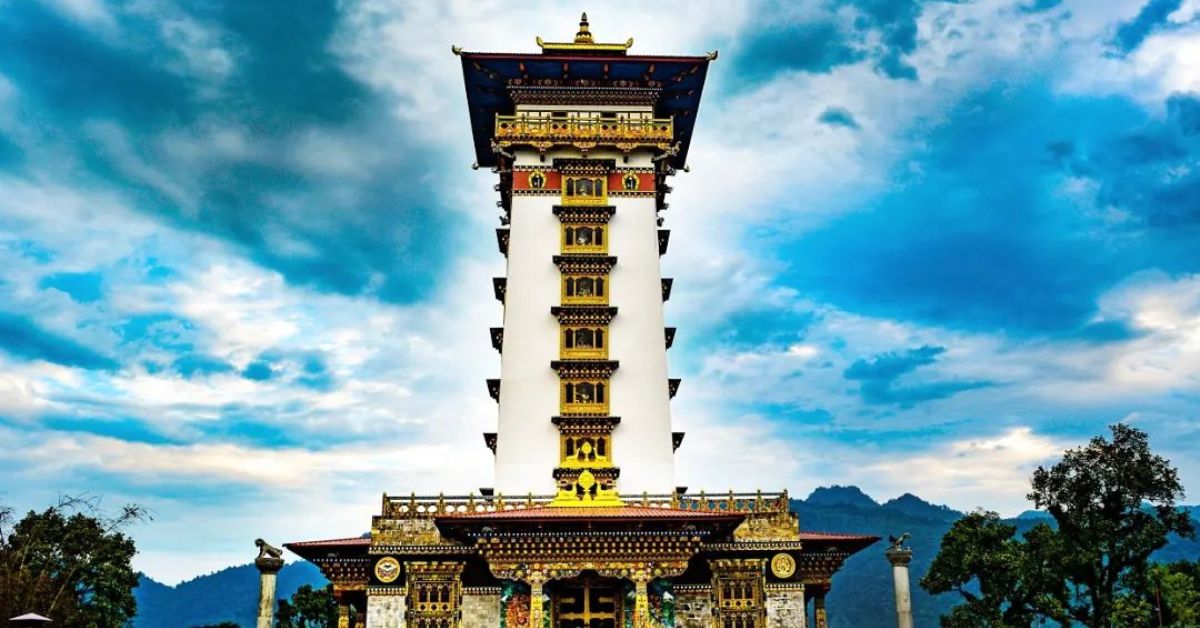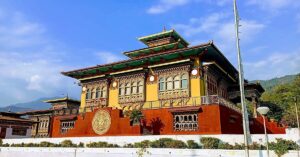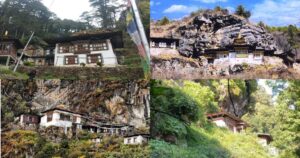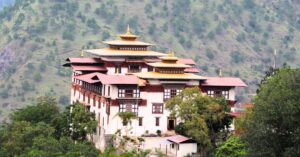Sangye Migyur Ling Lhakhang, also known as Mila Serkhar Guthog Lhakhang or Milarepa Lhakhang, is a nine-story tower dedicated to Jetsun Milarepa in Bhutan, symbolizing his journey from the practice of black magic to enlightenment. The tower is a replica of the original tower built by Milarepa in the 11th century.
The nine-story Sangye Migyur Ling Monastery is situated in Ramitey, approximately 16 kilometers from Phuentsholing, en route to Thimphu. The tower was built between 2013 and 2020, making it one of Bhutan’s tallest structures.
Today, it has become a significant pilgrimage site attracting pilgrims and tourists interested in Buddhism, offering them a space for reflection and connection to the profound legacy of Milarepa.
How to Reach Sangye Migyur Ling Lhakhang
Sangye Migyur Ling Lhakhang (Milarepa Tower) is located at Rigzinling, eight kilometers south of Sorchen on the Phuentsholing-Thimphu National Highway. It is about 16 kilometers from Phuentsholing.
Sacred Wonders to see at Milarepa Lhakhang
- A life-sized statue of Milarepa;
- 78 carvings of stories from Milarepa’s Namthar.
- A statue of Shakyamuni Buddha;
- Neten Chudru (Sixteen Arhats) paintings;
- Akshobhya, the Buddha of the East;
- Five Buddha Families and Eight Goddesses;
- A mandala and the paintings of Cakrasamvara;
- Guru Tsengye, the eight manifestations of Guru Padmasambhava;
- Drukpa Kagyu lineage;
- Karma Kagyu lineage;
- Statues of the Five Buddha Families;
- Buddha Amitabha, Hayagriya, and Kurukulle;
- Statues of Amitabha, Shakyamuni, and Maitreya.
Historical Significance of Milarepa Tower
In the 11th century, Jetsun Milarepa used black magic to avenge his mother’s enemies. This caused him deep remorse, and he sought atonement from master Marpa. The master Marpa subjected him to tough physical and spiritual trials, including building and repeatedly destroying several towers before finally approving the nine-story tower at Sekar Gutok Monastery in Lhodrak, Tibet. This Milarepa Tower has become a symbol of Milarepa’s perseverance, purification, and eventual enlightenment. Therefore, Sangye Migyur Ling Lhakhang in Bhutan is a tribute to Milarepa, reflecting his spiritual journey and teachings.
History of Sangye Migyur Ling Lhakhang
Lam Kelzang Tsheltrim made a pilgrimage to Lhodrak in the Kham region of Tibet in 2007 and visited the nine-storied Sekhar Guthok (Milarepa Tower). Instantly, he decided to build a similar tower in Bhutan to draw pilgrims from within and around the world.
So, Lam Kelzang sought the blessings of Sangye Nyenpa Rinpoche and the advice of the 17th Karmapa, Ogyen Trinley Dorje. The Royal Government of Bhutan supported 12 acres of land at Rigzinling, Phuentsholing. However, having sufficient funds to complete it was a crucial requirement for moving forward.
In 2010, His Holiness the Je Khenpo wrote letters of support, and the Sangye Migyur Ling Foundation, a charity led by Peter and other organizers under Lama Kelzang’s spiritual guidance, was established in Hong Kong, with a project budget estimated at around US$3.8 million.
Construction of Sangye Migyur Ling Lhakhang
The ground-breaking ceremony of Sangye Migyur Ling Lhakhang was presided over by His Holiness the 70th Je Khenpo on 17 November 2011. The construction was done in two phases. Phase One was the construction of a 9-story tower and shrine hall. Phase Two was responsible for the interior design and facilities, which included practice halls, libraries, and visitor facilities.
Description of Sangye Migyur Ling Lhakhang
Sangye Migyur Ling Lhakhang, also known as Mila Serkhar Guthog Lhakhang or Milarepa Lhakhang, is one of Bhutan’s tallest structures, alongside the Buddha Dordenma Statue and the Guru Nangsi Zilnon Statue. The Milarepa Lhakhang is a nine-story tower, accompanied by a Shrine Hall and a Shedra.
The ground floor of Sangye Migyur Ling Lhakhang features a life-sized marble statue of Milarepa in a cave, surrounded by four protective deities. The stories from Milarepa’s Namthar are also depicted in 78 carvings on this floor. On the second floor is a statue of Shakyamuni Buddha, accompanied by his disciples, Ananda and Sariputra. The floor also houses the Neten Chudruk (Sixteen Arhats) paintings.
The third floor is dedicated to Akshobhya, the Buddha of the East, and features paintings of the Five Buddha Families and the Eight Goddesses. In contrast, the fourth floor has a Mandala and 13 paintings of Cakrasamvara, the main yidam of the Kagyu Lineage.
The fifth floor features the eight manifestations of Guru Padmasambhava (Guru Tshengye), and the sixth floor is dedicated to the Kagyu lineage, featuring statues of Marpa, Milarepa, and Gampopa, as well as paintings of the four major and eight minor lineages.
The seventh floor houses the entire Drukpa Kagyu Lineage, the eighth floor has the whole Karma Kagyu Lineage, and the ninth floor houses the Five Buddha Families Statues.
The topmost floor, which is restricted to visitors, houses the Buddha Amitabha, Hayagriya, and Kurukulle facing south, as the powerful protectors of the Milarepa Tower and the country itself.
To the south of the Milarepa Tower is a Shrine Hall that houses the statues of Amitabha, flanked by Shakyamuni and Maitreya, following the advice of His Holiness the Je Khenpo. The monks’ practice hall, classrooms, quarters, and visitor facilities are located below the shrine hall.
Best Time to Visit Sangye Migyur Ling Lhakhang
The best time to visit Sangye Migyur Ling Lhakhang is during the spring (March to May) and autumn (September to November) months. You can visit the major pilgrimage sites of Chhukha with the Bhutan Pilgrimage Package.
Conclusion
Milarepa Lhakhang in Phuentsholing is a modern replica inspired by the historic Mila Serkhar Guthog Monastery in Tibet. The temple serves as a reminder of the transformative power of repentance, devotion, and hard work. It stands not only as a tribute to Milarepa’s life and teachings but also as a living institution for spiritual guidance, cultural preservation, and community well-being.
Sacred Places to Explore in Chhukha
Dokhachu Goenpa: Also known as Chapcha Dargay Choeling Goenzin Dratshang, is an Ekajati Lhakhang in Bhutan near a boulder cave pointing to the sky. It is located in Chapcha Gewog under Chukha Dzongkhag at an elevation of 3048m overlooking the village of Rin Thangkha. Lama Choeje Thinley Jamtsho, a grandson of Phajo Drugom Zhigpo, founded Dokhachu Goenpa in 1650.
Tumdra Ami Ney: This sacred site is the chief abode of the wish-granting goddess Lhamo Ekajati, located in Darla Gewog under Chhukha Dzongkhag in Bhutan. The sacred site is said to have been visited and blessed by Guru Rinpoche in the 8th century. Later in the 15th century, Thangthong Gyalpo discovered the Tumdra Aminey. In the early 18th century, Terton Drukdra Dorji spent a few years meditating and discovering “Ters” from the Ney.
Kharbandi Monastery: Also known as Rinchending Goemba, it is a Buddhist monastery perched 400 meters above sea level on a precious hill of Rinchending below the Phuntsholing–Thimphu Highway. The Royal Grandmother, Ashi Phuntsho Choden, built the monastery in 1967.
Zangdo Pelri Lhakhang: The zangtopelri in Phuentsholing is a small monastery representing the “celestial abode of Guru Rimpoche” built in the 1900s by Dasho Aku Tongmi. The temple is located in the middle of Phuentsholing town, just a few steps from the Bhutan-India border gate, enclosed by a recreational park.
Places to Explore in Phuentsholing
Phuentsholing, the second largest town in Bhutan, is a bustling border town that serves as an important economic hub and entry point for travelers from India. Phuentsholing blends traditional Bhutanese architecture with modern infrastructure. Here are some of the popular attractions in Phuentsholing:
Kharbandi Monastery: Also known as Rinchending Goenpa, it is a monastery near Phuentsholing that provides a tranquil spiritual escape.
Zangto Pelri Lhakhang: A small temple representing the celestial abode of Guru Rimpoche, located in the heart of Phuentsholing.
Bhutan Gate: A traditional Bhutanese gate that separates Bhutan from India, located in the Indo-Bhutan border town of Phuentsholing.
Palden Tashi Chholing Shedra: Dedicated to Buddhist education and spiritual learning, it is a Buddhist institute in Phuentsholing.
Phuentsholing Park: Phuentsholing Park is a popular destination in the town, with eucalyptus and sal trees, gazebos, a basketball court, and food stalls.
Amo Chhu Crocodile Breeding Centre: It is a wildlife conservation area dedicated to breeding and studying crocodiles. The center houses two species of crocodiles: gharials and muggers. Tourists can visit the center from 9 am to 5 pm.
Phuentsholing Vegetable Market: An integrated vegetable market designed to offer fresh produce in a more appealing environment for customers.
Amochu Suspension (Hanging) Bridge in Phuentsholing: Also known as the Hanging Bridge is one of the tourist attractions in Phuentsholing.
Enjoyed reading this blog?




